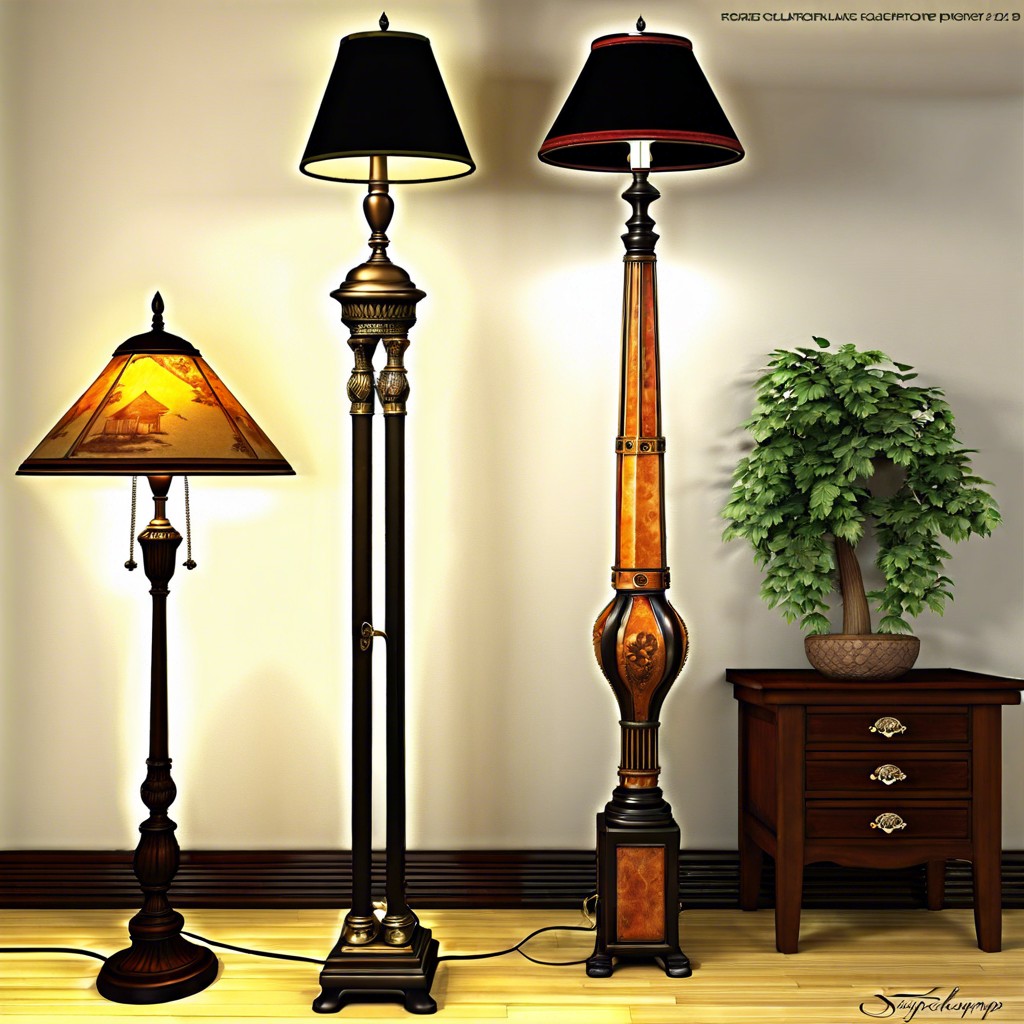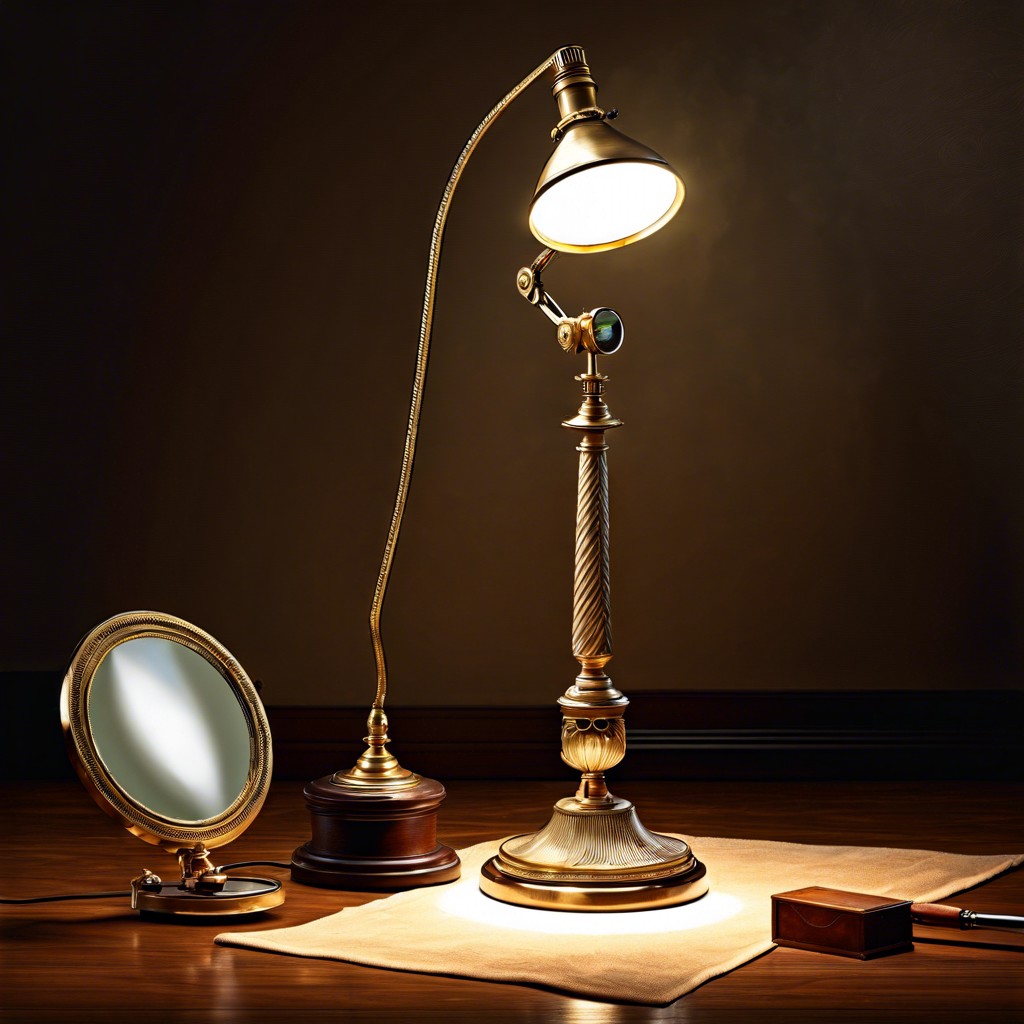Last updated on
Discover how to select the perfect antique floor lamp that suits your space and reflects your style.
Key takeaways:
- Antique floor lamps reflect different design eras and technological advancements.
- The materials used in antique floor lamps reveal their era and craftsmanship.
- The value of antique floor lamps is affected by factors such as age, condition, provenance, and rarity.
- Restoration of antique floor lamps requires delicate handling to preserve their historical integrity.
- When buying and selling antique floor lamps, be aware of legal considerations regarding import/export, provenance, and integrity.
Historical Significance of Antique Floor Lamps

Antique floor lamps do more than illuminate a room; they are historical markers representing different design eras and technological advancements. For example, think of the Art Nouveau period, which spanned the late 1800s and early 1900s. Here, we find lamps with organic curves and ornamental motifs reflecting a departure from the rigid designs of previous times.
As the Art Deco movement took center stage in the 1920s and 1930s, floor lamps showcased geometric patterns and sleek lines, mirroring society’s fascination with progress and the machine age. The shift towards mass production also began influencing lamp designs, making aesthetic lighting more accessible to the public.
Then there’s the midcentury modern period, roughly from the 1940s to the 1960s, where function and form met with simplicity. Floor lamps from this era often exhibit a minimalist yet functional design, revealing the post-war shift toward practicality and refined taste.
Each era’s floor lamps offer a glimpse into the past, acting as captivating conversation starters that link our modern lives with bygone days. As standing testaments to craftsmanship and style, they illuminate the rich tapestry of design history room by room.
Materials Used in Antique Floor Lamps

From brass to wrought iron, the constitution of antique floor lamps reveals much about their era and craftsmanship. Brass, a favored material, was chosen for its elegant sheen and durability. It was frequently found in designs ranging from the ornate Art Nouveau styles to the simpler lines of Colonial Revival lamps.
Wrought iron offered a sturdier aesthetic, often seen in Gothic or Arts and Crafts movement lamps, embodying a handcrafted vibe. Its weight and rigidity made these lamps as solid as they were stately.
Some lamps showcase intricate glasswork, especially in Art Deco pieces where vivid colors and geometric patterns became the hallmark. The Tiffany-style lamps, with their stained glass shades, are particularly cherished for their craftsmanship and vivid hues.
Marble bases, though less common due to their heaviness, denoted opulence and were typically seen in more luxurious residences or institutions.
Wooden materials, ranging from mahogany to oak, introduced warmth and a natural element into a room. These were often turned, carved, or embellished to form the stem of the lamp, showcasing the makers’ precision and attention to detail.
Porcelain, a finer material, capitalized on its glossy finish and was often painted with delicate scenes or floral motifs, popular during the Victorian era to add a touch of elegance and grace to an interior.
In the grand tapestry of antiques, these materials, among others, weave the story of floor lamps from different periods and styles. They speak not only to the design trends of their time but also to technological advances and the social fabric from which they emerged.
Factors Affecting the Value of Antique Floor Lamps

The allure of a bygone era captured in a functional piece of decor can make antique floor lamps quite valuable. However, deciphering their worth involves a cocktail of elements. Age, naturally, is a leading factor—older pieces often command higher prices due to their historical significance and scarcity. But it’s a dance, not a solo act. Condition swings in as a potent influencer; a lamp with its original finish and minimal wear can fetch a premium compared to one with damage or alterations.
Provenance can illuminate a lamp’s value significantly, turning an attractive item into a treasured heirloom. A piece with a verifiable history linked to a noteworthy person or an historic event shines brighter in the collector’s eye. Signature also plays a role in the high-stakes ballet of valuation. Floor lamps made by renowned designers or manufacturers can command astounding figures due to their esteemed genealogy.
Patina—the natural aging process of materials—adds depth and character to the lamp, often enhancing its appeal. Collectors are known to chase after this authentic look, which cannot be artificially recreated with the same charm. Rarity makes its grand entrance here, as less common styles or those from limited production runs can excite collectors to part with considerable sums.
Lastly, market trends samba in to affect value. Popularity can waft in and out like fickle seasons, making some lamps highly sought-after while others await their renaissance. Understanding these factors can shed light on the art and finesse of collecting and investing in antique floor lamps.
Restoration Considerations for Antique Floor Lamps

Reviving an antique floor lamp requires a delicate touch to maintain its historical integrity. First, assess the lamp’s condition. Look for frayed wires, rust on metal parts, and cracks in the glass. Safety comes first, so electrical components might need updating to meet modern standards. Seek a skilled professional for rewiring, keeping the lamp’s age in mind to select appropriate-looking cords and plugs.
When dealing with the finish, whether it’s metal or wood, aim to preserve the original patina. Stripping and refinishing should be done with caution, as overzealous cleaning can reduce value. It’s often enough to simply polish or wax the surface to bring out its aged luster.
For fragile parts like the shade, professional restoration is recommended, especially with materials like stained glass or fabric. Matching historical styles and materials is key. If the original shade is missing, research to find a period-appropriate replacement that complements the lamp’s design.
Lastly, remember that any alterations can impact the lamp’s collectibility. Always document the changes made during restoration, as provenance plays a crucial role in antiques. Keep spare parts, even if replaced, as they carry historical significance.
Approach each step with respect for the past to give the antique floor lamp a future shine.
Legal Considerations When Buying and Selling Antique Floor Lamps

Navigating the legal waters of antiques transactions can feel like a tightrope walk. For starters, familiarize yourself with regulations concerning the import and export of cultural goods; some antique lamps may have restrictions or require permits. Always request provenance to avoid the murky waters of items with dubious pasts. It’s an open secret that a clear lineage not only elevates a piece’s value but also keeps you clear of potential legal entanglements involving stolen or looted property.
Truth is, ignorance isn’t bliss in this game. A brush with the law over copyright or trademark infringement—for instance, unwittingly selling a replica as an original—is a hard lesson in due diligence. Dolling up an antique lamp? Remember that altering its integrity could change its categorization under heritage laws. So, tread lightly.
Lastly, when cash changes hands, ensure a detailed bill of sale is also part of the transaction—a straightforward step that’s often overlooked. It’s a simple piece of paper but serves as a mighty shield should questions ever arise about an item’s sale or ownership.




